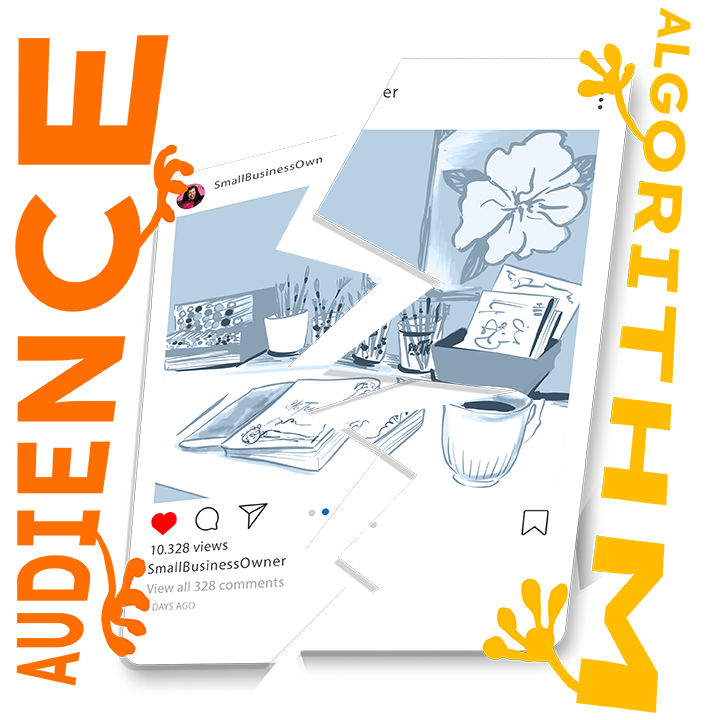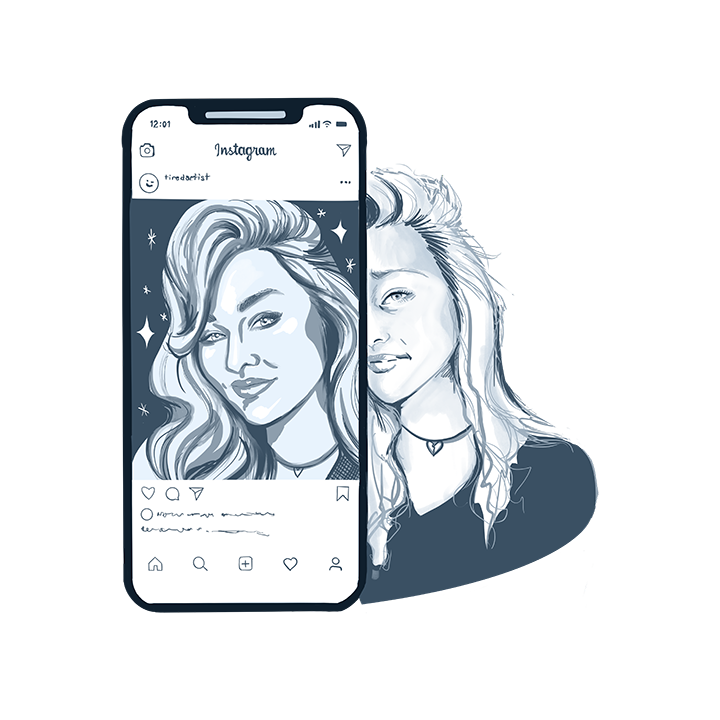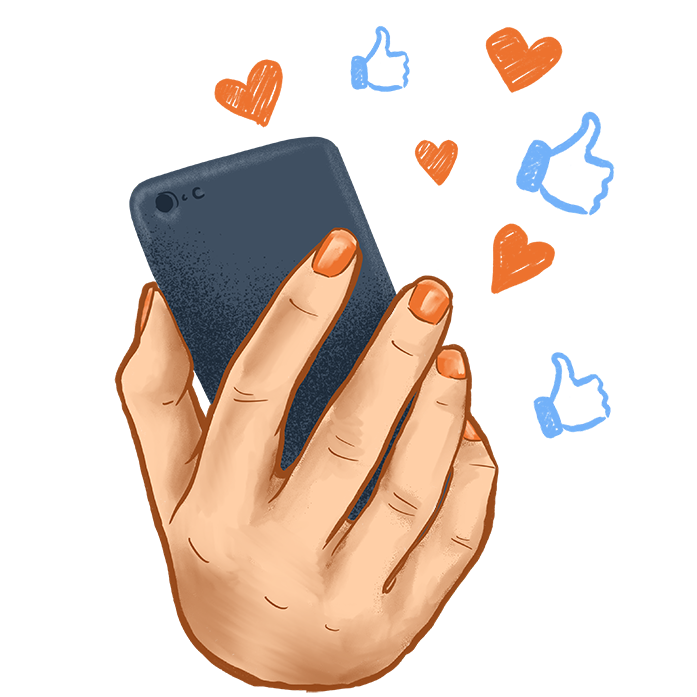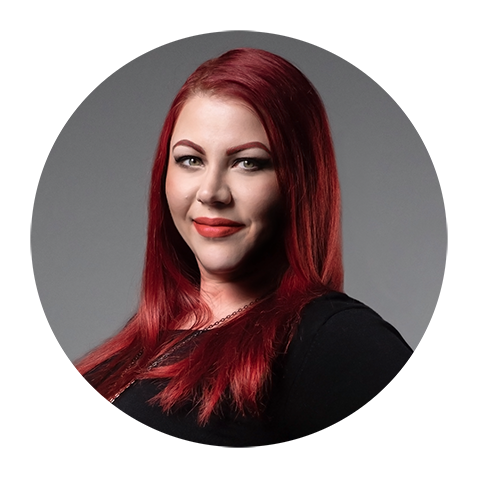An Honest Conversation with Two Small Business Owners
This year, Search Engine Land found that organic engagement continues to be shockingly (but not surprisingly) low on social media. Instagram’s engagement rate declined for the third year in a row, while Facebook and Twitter stayed put.
The reason for low engagement?
It’s all about the money. Platforms are pushing for more paid content and advertising. Forbes shared that Instagram made about $43 billion dollars in ad revenue last year, while Meta made an even more staggering $113 billion.
So how do we create engaging original content while not breaking the bank on boosted posts and Instagram ads?
I sat down with fellow TKGenius, Megan, to talk about our experiences over the past few decades across the changing landscape of social media.
But first, here's a little about our backgrounds...
I have been working in marketing for more than 10 years. Seven years ago, I started Everyday Akron, an online blog and social media community. Local businesses, non-profits and Akronites are featured on the website and each week someone new takes over the Instagram account to share their side of Akron and what makes it special to them. I’ve organically grown the account to over 10,000 Instagram followers and now have a team of people helping me grow the platform.
Megan has been a professional multimedia artist for more than 20 years. She has shown her art in galleries around the country and has been published in several books and magazines. This is all in addition to her professional career in graphic design.
(She also did all the artwork in this post.)
Ok, let’s get into this ...
Rachel: When did you start marketing your art on social media?
Megan: I’ve been sharing my art online since the early days—before social media was fully developed into what it is today. I joined MySpace in the early 2000s and made the move to Facebook soon after. When Instagram started, I joined the new platform, which at the time was the best place to share my art to reach the people most interested in seeing it.
Marketing Strategies & Tactics Over Time
Rachel: What sort of marketing and social media tactics did you begin using in the early days? Have they evolved over time?
Megan: In the beginning, it was mostly about having an online space to share art, not a real strategy to sell or market myself. I made social profiles on every new social sharing platform as they emerged. It wasn’t until later that I built my first website and started selling my art online and thinking about approaching my art as a business venture. At first, I would just post when I had new art to share, with no real plan in mind.
In 2023, my approach has evolved into something more detailed. It’s a lot more important to have a regular posting schedule and consistency in the content being shared. I’ve also narrowed in on a few platforms rather than trying to maintain 10 social profiles all at once.

Rachel: Oh my goodness, same! I used to try to do everything all the time. But now, I take a much more strategic approach to the platforms I use. Since Everyday Akron is unique in the fact that I’m not posting 24/7 to Instagram because there’s a new host each week, I have to get creative in sharing on other platforms where the core audience might not actually be. It’s often a strange catch-22 deciding what goes where and when.
Now that you’re posting more regularly with more consistent content, do you create formal strategies for your small business?
Megan: As a one-person business where I carry the burden of every single aspect of creating, marketing and producing my products, I often dream about being this organized and having a solid marketing plan. But the reality is there’s only one of me, and it often boils down to doing what I can, when I have time—rather than a cohesive strategy.
I have a set of overarching goals for my business and a rough idea of holiday promotions and sales, but beyond that it’s just doing what I’m able to do and sticking to it.
I will note that I always take a little time at the end of the year to look at the data and see where I was successful or fell short. I will compare that to previous years’ data to inform my efforts for the next year.
Rachel: It can be so hard running a small business on your own or even being the sole marketer of a small business. There’s just so much you can try and play with, not only on social media, but across all digital marketing tactics.
Megan: Yes, sometimes I wish I could hire five people or clone myself numerous times.
What is organic social media?
Any post, text, photo or video you share to social media—without spending money to increase your reach or conversions from it—is considered organic social media. The amount of time, energy, money and other resources that go into creating the content can vary.
Going Viral & Beyond
Rachel: Have you ever had a post that you considered went viral? How do we even define “going viral?”
Megan: Not really! Art rarely has buzzy, viral moments. Occasionally a publication will reshare my work or give me a feature or shoutout. This gives my visibility a nice boost, but nothing I’d describe as viral.
Sometimes those moments can bring new eyes or boost sales. However, keeping those people engaged past the viral moment can be tricky.
Rachel: Definitely! I feel for those random people who go viral for one goofy video and then have to rethink their entire online presence. (And maybe even their entire life.)
I recently had a short video I filmed at a Beyoncé concert and posted on my personal Instagram page “go viral.” The number of views kept ticking up and went past 750,000. It had more than 13,000 likes and 320 shares. I gained around a thousand followers from it, but ... if they’re expecting non-stop Beyoncé content, that isn’t going to happen. (As much as I’d love to provide that.)

So, you’re right – keeping people engaged with your content and perhaps what you’re selling beyond that viral moment is really tough but key.
Megan: As a content creator or brand on social media, you also deal with the paradox of being ready to go viral but not being able to choose what actually goes viral and when.
Creating for an Audience or an Algorithm
Rachel: Ok, heads up ... I'm going to use a polarizing word ... What does the “algorithm” mean to you in general?
Megan: In theory, the algorithm serves to narrow down vast amounts of content, serving it to the people most likely to interact and enjoy what you’re posting.
The actual reality of it in 2023 is that the algorithm often serves to gatekeep those same people from seeing your posted content unless you’re willing to pay for boosting your posts.
Organic traffic is quickly becoming a thing of the past.
Rachel: Do you think it’s better to create content that resonates with your audience or the algorithm?
Megan: I think you have to consider the algorithms of the social platforms if you want to be seen, but you should always be creating for your audience and remain authentic to your brand.
It’s ok to hop on fun trends from time to time, but the majority of what you post should stay true to your brand’s voice and message rather than chasing viral moments and whatever might be popular that day.
While it might be exciting to see a post get a lot of likes, that often doesn’t really translate to new clients or sales.

Rachel: I’m always asked about the “best” content a host has shared on Everyday Akron. And I never have a specific answer. However, I do think that the most unexpected content gets a surprising amount of engagement. I know what the popular topics are across hosts, but every now and then, there’s a random subject of a post that gets a lot of likes and comments.
So, I think you hit the nail on the head when you said, “... the majority of what you post should stay true to your brand’s voice and message rather than chasing viral moments ...” That consistency is going to prep your core followers to engage with your well-thought-out content, while in turn training the algorithm to show your content to the right audience.
Megan: Yes, until the algorithm changes or goes rogue.
Rachel: Very true!
Rachel: When it comes to “vanity metrics” like comments and views, what do you think has the most weight in the algorithm?
Megan: I think the most telling metric is active engagement. For example, comments signal a deeper level of engagement than passive view counts or likes. It shows that your audience was willing to stop their scrolling long enough to become part of the conversation with you.
Rachel: Do you look at your analytics at all?
Megan: I think it's important to keep an eye on the metrics, but you can’t lose sight of what your actual goals for social media are.
Consider what you’re hoping to gain from your investment of both time and money in a specific platform. The data can help guide those efforts and show you what your followers are most interested in. Then, you can find the types of posts that work best for your brand and work your brand voice and products into those.

Balancing Your Business and Personal Brand
Rachel: I find that being on social media as a human being and as a business is an odd balancing act. As yourself, you’re never giving your full self away to followers. Have you felt this way too?
Megan: Yes. It’s hard to find the right balance between sharing too much or not enough of yourself as part of your business and brand, but the research is clear on this point.
People resonate with other people more than products. If you want people to be invested in your brand and interested in what you’re doing, sharing parts of yourself as a person is a key element of successful marketing.
It can be really daunting to open yourself up to the masses, but it ultimately helps give your brand authenticity and a voice that sets you apart from being a faceless corporate entity.
Rachel: Thankfully, Everyday Akron is about people and not products. But even then, the people can become the product. It’s interesting to watch people I know tweak the way they speak on social media when they know more eyes are on them while hosting Everyday Akron.
I even get caught up in that myself. I’m quite introverted and forever anxious, but my personality on Instagram shows a very bubbly, positive human. It’s not necessarily a false representation of me, but it’s not the whole story. It’s hard and really strange to reconcile when meeting people from Instagram out in the real world.
Megan: Yes, if I think too hard about this balancing act, I start subconsciously letting it inform what I’m doing in my actual work that isn’t based in social media. And that is not a good feeling.

Rachel: All brands on social media are looking for engagement and the magical ability to start fresh conversations each day. But as you and I both know, social media users are quite passive in how they scroll through the apps. How do you think we can get around that?
Megan: I think this is where the personalization and sharing of the face behind the brand becomes important. Understanding what your followers want from you has to come into play here. Because just like you, every single other business and brand out there is trying to do the same thing … spark a conversation, get that engagement from their audience, snag that sale.
Social media prefers when people pick a lane and fully occupy that, rather than trying to be part of every single conversation. Fostering a connection and conversation with your core audience yields better results than trying to insert yourself into every corner of the internet without having something meaningful to say.
Rachel: They say all bad press is good press. So when we do get that sweet, sweet social media engagement, are all bad comments good comments?
Megan: This is a tough question. In the eyes of the algorithm, all engagement is an indicator of success, regardless of the content of the comments. It weighs negative and positive comments about the same.
Posts often go “viral” not because they’re useful or insightful, but because they spark negative emotions that encourage people to weigh in and debate with the original poster or others in the comments.
But as a brand, it’s important to have integrity about what you’re saying online, rather than stirring up controversy for more views and losing the trust of your customers.
Rachel: That’s such a good point.
What is paid social media?
Paid social media is when you create an advertising campaign through a social media platform or boost a specific post. This helps to target the audience you want to see your content (and those who will most likely engage with it or convert) and can also show your content to a wider audience than just your followers.
Pay to Play: Is Paid Engagement Still Valuable?
Rachel: I feel that organic engagement is the fun, honest and endearing part of social media. But I know that you also have to pay-to-play at times. Is that paid-for engagement still valuable?
Megan: Engagement is the only true indicator of loyalty and deeper interest in a world where our attention spans are now shorter than a goldfish’s.

If your audience is taking the time to stop scrolling and comment, sign up for a mailing list, or go to your website, that’s a clear sign they’re more invested in the long-term relationship with you as a brand and what you have to say.
An ad or boosted post might initially bring them to you, but shallow gains are easily lost if you’re not offering a reason for those people to keep browsing your products or reading more about your brand.
Rachel: As a small local business or a business just starting out, how do you make noise on social media? How do you stand out in a sea of professional content creators and big budget businesses?
Megan: Identifying your voice and “lane” are important here. Social media has become a big noisy room to shout across, and if you’re trying to speak to everyone all at once, no one can really hear you without a big budget.
The key to reaching people—and keeping them interested—is to identify the smaller group(s) that make up your core audience and speak directly to them with relevant content that provides value that goes beyond “buy my product!”
Rachel: You make it sound so easy! But I think you’re right. It’s something we need to start doing and keep doing. People will start to notice.
It’s kind of wild that your art and my community platform are fighting for attention in people’s feeds that may also contain ads for durable iPhone cases, an influencer’s latest beauty haul, someone baking a 4-tiered cake, and recap clips from RuPaul’s Drag Race.

Moving the Needle: What it Really Takes
Rachel: Ok, to wrap things up ...
From when we started using social media many moons ago to now, if people are using social media differently and not engaging as much, how do we still move the needle for our online communities and for TKG clients?
Megan: It’s important to first set clear and realistic goals for what you want from social media. Are you doing it for brand awareness, to gain new customers, to get feedback about your product, etc.? It can be hard to define the ROI with social media, so having clear goals in mind can guide your efforts in a direction that brings you better results.
Next, I would clearly define your brand’s voice and perspective, pick a lane and consistently stick with it. Because social media sorts every post and user into smaller specialized groups, it’s still the best way to target the right people who will be the most interested in what you have to say.
Finally, don’t skip out on a plan to follow through with your efforts on social. For example, if you managed to get new eyes on your product or engaged your audience in a conversation, your next step is to keep that conversation going by funneling them to your email list or store with calls to action. This is where you can really start to get more meaningful data about what social media is actually doing for your business.

Rachel: I couldn’t have said it better.
Once you start digging into all of this, it can become very overwhelming. Especially if you wear all of the hats in your business. (As you and I both know!)
I guess my best advice would be for anyone reading this to connect with TKG to find out how we can partner with your business and take your digital marketing to the next level.
We have a deep team of experts who I enjoy working with (Megan being only one of them), so if you’re reading this, reach out to us! We’d love to learn more about your business and social media experiences.





